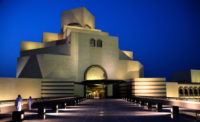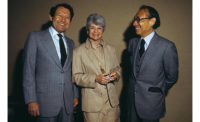Suzhou Museum by I. M. Pei
Jiangsu Province, People’s Republic of China

Photo © Lin Mei
Architects & Firms
with Pei Partnership Architects
For any architect concerned with contextual design, Suzhou presents a formidable challenge. A canal city founded 2,500 years ago, old Suzhou (a center of silk cultivation and commerce) represented the apogee of urban sophistication—a place where the enclosed garden evolved into a naturalistic universe in miniature.
In 2001, the mayor of modern Suzhou, approached the architect I. M. Pei, FAIA, to design a museum at a critical juncture: deep in the historic district at the intersection of two canals in the northeastern corner of the city, adjacent to a historic palace, and backed against an ultra-sensitive international treasure, the Garden of the Humble Administrator (1506–21).
Daunting limitations defined the project boundaries. First, the city required a 150,000-square-foot museum to showcase its 30,000-piece collection of Chinese art that spanned millennia. The design, according to officials, needed to reflect contemporary life, yet height limitations dictated that a structure not exceed 52.5 feet—no more than 20 feet adjacent to the existing historic buildings. Scholars at Beijing’s Tsinghua University suggested that the architect respect the prevalent Suzhou coloration, white and gray, colors that serve as a backdrop for the community’s leafy green gardens and streets.
The obvious solution to height limitations, which Pei had employed at the Pyramide du Louvre (1989), would be to depress the building’s mass into the earth. The high water table in Suzhou, a water-encircled city, compounded the difficulty of excavating very deep. Requirements demanding open space and greenery added complexity to a solution that ultimately split the difference: two stories above grade and one below, with a large quadrant on the ground plane left as garden space.
Responding to Suzhou’s heritage, the architect placed a walled garden with a void at the museum’s core. Rather than compete with the landscape iconography familiar to tourists (miniaturized trees, sculptural rock formations, scenic twists and turns), the garden’s emphasis lay in the simplicity of water, rocks, and sky—more akin to the Taoist philosophy of the Tang Dynasty (618–907) than to the elaborate conventions of later centuries.
Water provides a literal link to the Garden of the Humble Administrator, flowing through the common wall at the rear of the older garden into a new pond at the new museum, an open space punctuated by a stylized garden pavilion. The lotus pool formed by this stream acts as an orienting device throughout the museum, visible from multiple points within the courtyard plan, reflecting the sky into another dimension.
Surrounding the lotus pool, the building plan outlines a framework of galleries on the one hand and administrative spaces on the other. The octagonal great hall at the entry, lit by a custom chandelier, frames the garden while encouraging the visitor to turn and proceed. Protected exhibition spaces lie off passageways, sized to showcase the small, precious objects that characterized Suzhou craftsmanship for an aristocracy, including ceramics, paintings, jade, and woodcarvings. A painting gallery resides on the second level, up a grand staircase backed by a granite wall and smoothed by running water. On the garden’s eastern side, Pei insisted on a contemporary gallery to showcase new Chinese art.
The contemporary deployment of stone differentiates the Suzhou Museum from earlier Chinese building. Where roofs in generations of historic Chinese architecture had been tile-covered, curving upward at the edges, the Suzhou Museum substitutes granite. The architect contended that tile leaked and lacked uniformity. After studying the shapes of traditional buildings and the shades of stone readily available (including the effects of rain on the color), the Pei group settled on China Black granite, which now covers roofs, outlines windows, and caps white walls. The effect is crisp, articulated, and decidedly modern.
The Suzhou Museum represents Pei’s highly personal essay on building in strong context in this cradle of Chinese culture. Referential without explicitly copying precedent, respectful of its surrounding constraints, the complex nevertheless breaks no new ground. If the Suzhou Museum sometimes reverts to the scenographic, the walled-in, three-dimensional project succeeds by doing no harm to its hypersensitive environment while offering a new generation of Chinese architects a modest model drawn from precedent—to reflect on, to debate and criticize, to react to, and to create their own new work.
PeopleOwner Completion date: October 2006 Gross square footage: 183,000 Owner: Suzhou Municipal Administration of Culture, Radio and Television Architect Pei Partnership Architects Partners in Charge: Chien Chung Pei, Li Chung Pei Project Manager: Gerald Szeto Site Architect: Bing Lin Design Team: Flora Chen, Yi-Jiun Chen, Haruko Fukui, Richard Lee, Kevin Ma, Jeff Stumacher, Hajime Tanimura Architect of record: Interior & Exhibition designer: Landscape designer: Engineer(s): Mechanical Engineer: Jaros Baum & Bolles Consulting Engineers Consultant(s) Lighting: Fisher Marantz Stone Acoustical: XU Acoustique, France Audio-Visual: Shen Milsom & Wilke Urban Planning: T’ing Chung Pei, AICP Traditional Chinese Architecture: SouthEast University, Nanjing, Jiangsu Province, China Vertical Transportation: Barker Mohandas General contractor: Suzhou No.1 Construction Group Co., Ltd Photographer: Kerun Ip CAD system, project management, or other software used: AutoCAD
|
ProductsExterior cladding Doors Interior finishes Lighting Downlights: ERCO Task lighting: ERCO Exterior: Bega, William Artists International Controls: Dynalite Conveyance Plumbing |




